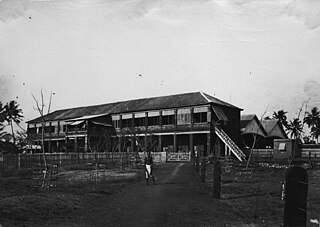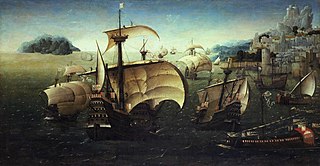
Year 1571 (MDLXXI) was a common year starting on Monday of the Julian calendar.

The State of India, also known as the Portuguese State of India or Portuguese India, was a state of the Portuguese Empire founded six years after the discovery of the sea route to the Indian subcontinent by Vasco da Gama, a subject of the Kingdom of Portugal. The capital of Portuguese India served as the governing centre of a string of military forts and maritime ports scattered along the coasts of the Indian Ocean.

The Battle of Diu was a naval battle fought on 3 February 1509 in the Arabian Sea, in the port of Diu, India, between the Portuguese Empire and a joint fleet of the Sultan of Gujarat, the Mamlûk Burji Sultanate of Egypt and the Zamorin of Calicut.

Tanur is a coastal town, a municipality, and a block located in Tirur Taluk, Malappuram district, Kerala, India. It is located on the Malabar Coast, 9 kilometres (5.6 mi) north of Tirur and 9 kilometres south of Parappanangadi. It is the 17th-most populated municipality in the state, the fourth-most populated municipality in the district, and the second-most densely populated municipality in Malappuram district, having about 3,568 residents per square kilometre as of the year 2011.

The siege of Diu occurred when an army of the Sultanate of Gujarat under Khadjar Safar, aided by forces of the Ottoman Empire, attempted to capture the city of Diu in 1538, then held by the Portuguese. The siege was part of the Ottoman-Portuguese war. The Portuguese successfully resisted the four-month long siege.

The siege of Cannanore was a four-month siege, from 27 April 1507 to 27 August 1507, when troops of the local ruler, supported by the Zamorin of Calicut and Arabs, besieged the Portuguese garrison at St. Angelo Fort in Cannanore, in what is now the Indian state of Kerala. It followed the Battle of Cannanore, in which the fleet of the Zamorin was defeated by the Portuguese.
The Kingdom of Tanur was one of the numerous feudal principalities on the Malabar Coast of the Indian subcontinent during the Middle Ages. It was ruled by a Hindu dynasty, claiming kshatriya status, known as the Tanur dynasty. The kingdom comprised parts of the coastal Taluks of Tirurangadi, Tirur, and Ponnani taluks in present-day Malappuram district and included places such as Tanur, Tirur (Trikkandiyur) and Chaliyam. The coastal villages of Kadalundi and Chaliyam in the southernmost area of Kozhikode district was also under Tanur Swaroopam.
The Fifth India Armada was assembled in 1503 on the order of King Manuel I of Portugal and placed under the command of Afonso de Albuquerque. It was Albuquerque's first trip to India. It was not a particularly successful armada - navigational mistakes scattered the fleet on the outward journey. Ships spent much time looking for each other and several ended up travelling alone.
The Sixth India Armada was assembled in 1504 on the order of King Manuel I of Portugal and placed under the command of Lopo Soares de Albergaria.

The Battle of Cochin, sometimes referred as the Second Siege of Cochin, was a series of confrontations, between March and July 1504, fought on land and sea, principally between the Portuguese garrison at Cochin, allied to the Trimumpara Raja, and the armies of the Zamorin of Calicut and vassal Malabari states.

The Kingdom of Kozhikode, also known as Calicut, was the kingdom of the Zamorin of Calicut, in the present-day Indian state of Kerala. Present-day Kozhikode is the second largest city in Kerala, as well as the headquarters of Kozhikode district.

Chaliyam is a village situated at the estuary of Chaliyar in Kozhikode district of Kerala, India. Chaliyam forms an island, bounded by the Chaliyar in the north, and River Kadalundi in south, and the Conolly Canal in the east. It is located just opposite to Beypore port. Chaliyam was the former terminus of the South-West Line of the Madras Railway. Chaliyam is also famous for the Guinness World Records holder Muhammed Adil, a P.M who covered around seven km in the Chaliyar River with his hand and legs tied with ropes.
Malappuram is one of the 14 districts in the South Indian state of Kerala. The district has a unique and eventful history starting from pre-historic times. During the early medieval period, the district was the home to two of the four major kingdoms that ruled Kerala. Perumpadappu was the original hometown of the Kingdom of Cochin, which is also known as Perumbadappu Swaroopam, and Nediyiruppu was the original hometown of the Zamorin of Calicut, which is also known as Nediyiruppu Swaroopam. Besides, the original headquarters of the Palakkad Rajas were also at Athavanad in the district.

The War of the League of the Indies was a military conflict lasting from December 1570 to 1575, wherein a pan-Asian alliance attempted to overturn the Portuguese presence in the Indian Ocean. The pan-Asian alliance was formed primarily by the Sultanate of Bijapur, the Sultanate of Ahmadnagar, the Kingdom of Calicut, and the Sultanate of Aceh. It is referred to by the Portuguese historian António Pinto Pereira as "the League of Kings of India", "the Confederated Kings", or simply "the League". The alliance undertook a combined assault against some of the primary possessions of the Portuguese State of India: Malacca, Chaul, the Chale fort, and the capital of the maritime empire in Asia, Goa.
The siege of Kottakkal also known as the battle of Cunhale River was a military engagement between the joint forces of the Portuguese Empire and the Zamorin of Calicut against the stronghold of Kunjali Marakkar Kottakkal called by the Portuguese Forte Branco.

D. Luís de Ataíde, 1st Marquess of Santarém and 3rd Count of Atouguia, was a Portuguese nobleman, military commander and statesman of the 16th century, who stood out for his military feats in the Portuguese State of India. He served as Viceroy of India for two non-subsequent terms.

Adil Shahi–Portuguese conflicts refers to the various armed engagements that took place in India between the Portuguese Empire and the Sultanate of Bijapur, ruled by the Adil Shahi dynasty, whose rulers were known to the Portuguese as Hidalcão.

The First Luso–Malabarese War was the first armed conflict fought by the Portuguese Empire in Asia, and the first of nine against the Zamorin of Calicut, then the preeminent power on the Malabar Coast, in India. Hostilities broke out in 1500 and continued for thirteen years until the ruling Zamorin was assassinated and his successor signed a peace treaty with the Portuguese governor of India Afonso de Albuquerque.
The Zamorin–Portuguese conflicts were a series of military engagements between the Zamorins of Calicut and the Portuguese Empire during the 16th century in the Indian Ocean.













